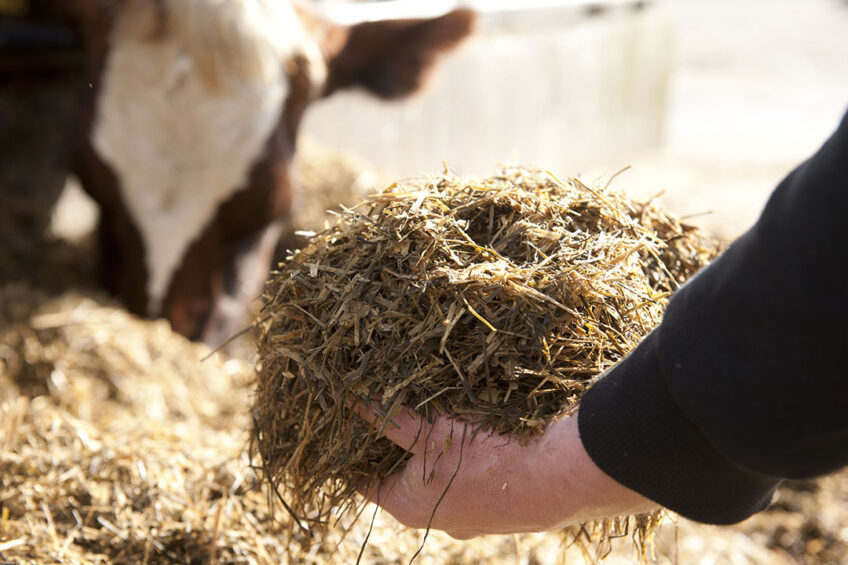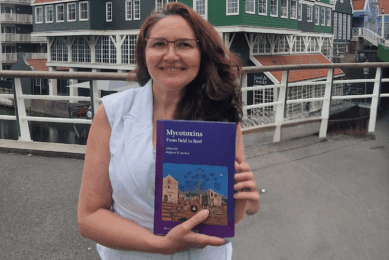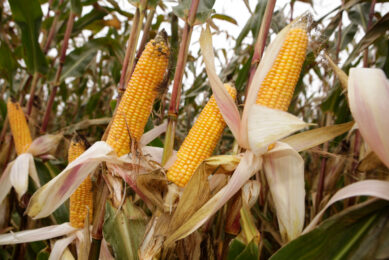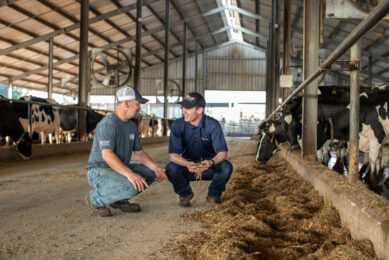What are masked, modified and emerging mycotoxins?

More than 400 mycotoxin compounds have been identified, produced by hundreds of different fungal species, including Fusarium, Penicillium and Aspergillus species.
After examining peer-reviewed papers on the cost implications of mycotoxins at a similar risk level, it was calculated that cows may produce 1.6 litres (3.5 pounds) of milk per day less when consuming mycotoxins. Additionally, milk somatic cell count (SCC) was shown to increase by 39%. With this loss of performance, the reduction in profitability per cow is an estimated decrease of € 1.39 (US$ 1.54) per day.

Historically, certain mycotoxins were considered more relevant to the agricultural industry. But, as research and laboratory techniques advance, the list of mycotoxins harmful to humans and animals is growing. These are often categorised as masked, modified or emerging mycotoxins.
Masked mycotoxins
Mycotoxins can be produced in parent structure form – like deoxynivalenol (i.e., DON or ‘vomitoxin’), for example. They may also be modified into numerous structurally related compounds (e.g., DON-3-glucoside) that are often called ‘masked mycotoxins’. These modifications may be completed by the fungus itself or by the host plant on which the fungus is growing.
For the host plant, the formation of masked mycotoxins happens through a method of detoxification, as these compounds are often less toxic for the plant. Although this process may reduce the toxicity to the host plant itself, these masked mycotoxins may remain toxicologically relevant for humans and animals, as the gastrointestinal tract can cleave back to the original mycotoxin.
Modified mycotoxins
These can form when the fungal organism modifies the parent structure. An example is the production of altered forms of DON, such as 3-acetyl-deoxynivalenol and 15-acetyl-deoxynivalenol.
Modification can also occur within humans and animals. This happens when metabolism alters mycotoxins, such as when aflatoxin B1 is converted into aflatoxin M1. The process of modifying mycotoxins may cause these compounds to become either more or less bioavailable, resulting in compounds with either more or less toxicity.

Mitigating mycotoxins is a huge global challenge with no universal solution. Developments need to happen from all sides of the supply chain; a safe harvest, safe storage and animals prepared to safely deal with mycotoxin exposure. Here, the latest breakthroughs across these areas are explored.
Emerging mycotoxins
The lesser-known, or newer, forms of mycotoxins are ‘emerging mycotoxins’. This term, which covers a range of mycotoxins, refers to the theory that these are newer classes of mycotoxins that are neither routinely analysed nor legislatively regulated. Mycotoxins that fall into this category include enniatins, beauvericin and moniliformin. Information on their occurrence and toxicity is limited, although these mycotoxins have garnered more attention in recent years.
Thankfully, there are methods for identifying and combatting these varieties of mycotoxins.
Although rapid tests and enzyme-linked immunosorbent assay (ELISA) technologies can provide valuable information about the parent mycotoxins, and even some modified mycotoxins, advanced laboratory techniques – such as liquid chromatography with duel masked spectrometry (LC-MS/MS) – must be employed to detect a broader spectrum of mycotoxins including masked, modified and emerging mycotoxins. The Alltech 37+® mycotoxin analysis utilises LC-MS/MS technology. In total, 5 new and emerging mycotoxins have been added to the testing panel, bringing the total number of detectable mycotoxins to 54. These new additions further increase the understanding of mycotoxin occurrence and the potential risk to animal performance.
“Since adding these mycotoxins to our analytical capabilities, we have already seen a high frequency of samples with these contaminants,” explained Dr Patrick Ward, Ireland analytical services laboratory manager, Alltech. “As we test more samples and accumulate more data, we will strengthen our understanding of these mycotoxins.”
The Alltech 37+ test is the cornerstone of our mycotoxin control programme. Between our labs in Lexington, Kentucky, and Dunboyne, Ireland, we have run over 32,000 samples, each searching for over 50 mycotoxins in animal feed.
These test results provide a realistic picture of feed contaminants in feed ingredients, forages or TMRs to speed up the process of diagnosis, suggest effective remediation and help move towards an effective mycotoxin control plan.
2019 Alltech mycotoxin survey
Looking at the 37+ results since June 1, 2019, the analytical services laboratory has analysed 479 TMR samples from around the world.
Figure 1 shows the number of mycotoxins identified per TMR sample out of the 54 mycotoxins tested. More than 99% of samples were contaminated with at least one measurable mycotoxin, and the average number of mycotoxins identified was 7.19.
Figure 1 – Distribution of number of mycotoxins in selected samples.

Figure 2 outlines the prevalence of each mycotoxin group. It is clear that emerging mycotoxins are a category that needs further attention, based on their recurrent contamination of dairy diets (69.3% of tested samples).
Figure 3 evaluates the average mycotoxin concentration found in TMRs (ppb) against the practical limits outlined by Alltech. From this, while no one mycotoxin represents a high risk (below the ppb threshold), there is a greater potential risk to the health and performance of cows, as is expressed by the Risk Equivalent Quantity (REQ). This represents the overall threat to a particular species’ health and performance based on the cumulative effect of the mycotoxin groups present. It is also important to consider that, while these are average results, the maximum levels found in TMR samples can be considerably higher.
Figure 3 – Average mycotoxin assessment for performance impairment for dairy cows.

Storage and new challenges
Mycotoxin contamination levels do not stabilise, as new challenges can arise after harvest. The crop condition at harvest and the storage environment (temperature, oxygen, moisture) will determine if these levels rise during storage and increase the risk to cows. Over the past 2 years, contamination in stored forages has grown throughout the feeding year, and these levels need to be monitored. Producers need to keep in mind that the risk from mycotoxins is a moving target; what you feed today is not necessarily what you will feed tomorrow.
Penicillium mycotoxins, while already present in the tested samples at harvest (occurrence of 40.9%) are likely to increase during storage, with a potential impact on animals’ health. These include:
- Penicillic acid: A mycotoxin isolated from various strains of Penicillium that demonstrates mutagenic and cytotoxic effects. The main impact on dairy cows is the potential disruption of rumen function based on the anti-microbial effects that this mycotoxin can have. As a result, the production of microbial protein and VFAs may be altered, thereby impacting milk production and quality. This mycotoxin can also have a direct effect on immune cells such as macrophages. This can affect overall immunity, result in high SCC counts and increase the incidence of secondary diseases.
- Gliotoxin: This is primarily produced by the Aspergillus group of moulds, but can also come from the Penicillium species. Gliotoxin is an immunosuppressive mycotoxin. It can induce apoptosis (cell death) or activity of immune cells such as in monocytes, neutrophils and dendritic cells. As a result of cellular damage to the immune system and other internal organs, gliotoxin may impair respiratory cell function and may promote the development of pulmonary aspergillosis. Typical symptoms in animals may include diarrhoea of varying severity, lung and internal organ damage and strong immune suppression that can result in more secondary viral or bacterial diseases.
Proactive management
The following are critical control factors in producing high-quality feed:
- Chop length (1.3–2 centimetres; 0.5–0.8 inches) and timing for the cut to ensure an optimum balance between dry matter content (30%–35% moisture) and yield.
- Consistent compacting to achieve a density at a minimum of 6.8 kilogrammes (15 pounds) dry matter per cubic foot.
- Seal the bunker quickly to keep oxygen and water out and ensure an anaerobic environment for the silage to ferment correctly.
- Execute proper pit management. When extracting silage, remove a minimum of 15 centimetres (6 inches) per day and work your way vertically from the top, down the silage face.
- Remove spoiled and mouldy silage to reduce exposure and ingestion of mycotoxins.
Good forage management at harvest, and after, ensures maximum return from a valuable feed source. And again, in case of any suspicion of mycotoxins, an analysis is always warranted to advise on the best strategy.
Mycotoxins Knowledge Centre: An information hub on mycotoxins from regulations to their impact on livestock and much more!
Join 13,000+ subscribers
Subscribe to our newsletter to stay updated about all the need-to-know content in the dairy sector, two times a week.










